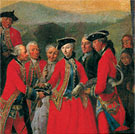|
||||||||||||||||
|
|
||||||||||||||||
|

Humans, Nature and Birds |
From Room 5: Birds and Promoting Conservation |
||||
|
|||||
 Plate 35 |
|
In 1920, U.S. and Canadian governmental agencies took over the program, and now bird banding is a coordinated global effort that provides data on bird behavior, survival, and travel.[78] Banding serves other pur- poses, too. For example, it allows the identification of individuals in field studies where researcher interference must be minimized. (In cases where interference must be reduced even more, micro- phones are used to record voice prints that can be analyzed electronically to identify species and, in some cases, region of origin.) As interest in migration and dispersal have intensified, scientists have banded birds to track them as they travel to find resources or mates, as they move to their breeding grounds, or as they just leave home when habitat and climate change threaten their survival. To
find out where birds have been, researchers can analyze genetic differences among birds, chemical signatures of feathers, and routes taken by birds wearing minute tags keyed to global positioning systems (GPS). These sorts of analysis are enriching the field of movement ecology, which is building a frame- work to help us assess how birds navigate and how changes in patterns might reflect changes in environmental quality.[79] |
|||
Plates 35 and 35a. Untitled [The banding of a heron] and detail, probably 1764, by an unknown artist |
|||||